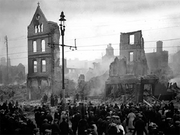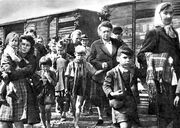| Irish Republic Poblacht na hÉireann
(Saorstát Éireann) (Irish) Timeline: German Heritage | ||||||
|---|---|---|---|---|---|---|
|
||||||
| Anthem: Amhrán na bhFiann (The Soldier’s Song) |
||||||
| Capital | Dublin | |||||
| Largest city | Dublin | |||||
| Official languages | English and Irish | |||||
| Regional languages | Ulster Scots | |||||
| Religion | Protestant Catholic |
|||||
| Demonym | Irish | |||||
| Government | Unitary parliamentary republic | |||||
| - | President of Ireland | Michael D. Higgins | ||||
| - | Taoiseach | Simon Coveney (Sinn Féin) | ||||
| Legislature | Oireachtas | |||||
| - | Upper house | Seanad Éireann | ||||
| - | Lower house | Dáil Éireann | ||||
| Establishment | ||||||
| - | Proclamation | 24 April 1916 | ||||
| - | Declaration | 14 April 1918 | ||||
| - | Joined the CEEU | 7 July 1925 | ||||
| Population | ||||||
| - | 2016 census | 6,572,728 | ||||
| - | Density | 77.8/km2 201.5/sq mi |
||||
| Currency | Irish Pound (IEP) |
|||||
| Date formats | dd.mm.yyyy | |||||
| Drives on the | Left | |||||
| Internet TLD | .ie | |||||
Ireland (Irish: Éire), also known as the Republic of Ireland (Poblacht na hÉireann), is a country in North-Western Europe, occupying the entire island of Ireland. It is surrounded by the Atlantic Ocean, with the Celtic Sea to the south, St George's Channel to the south-east, and the Irish Sea to the east. It is a unitary, parliamentary republic. The legislature, the Oireachtas, consists of a lower house, Dáil Éireann, an upper house, Seanad Éireann, and an elected President (Uachtarán) who serves as the largely ceremonial head of state, but with some important powers and duties. The head of government is the Taoiseach (Prime Minister, literally 'Chief', a title not used in English), who is elected by the Dáil and appointed by the President; the Taoiseach in turn appoints other government ministers.
History[]

Part of Belfast after communal fighting between the IRA and UVF.

Flag flown by Irish Unionists

Ulster Catholics expelled by the UVF during the civil war
Even since Ireland had gained independence in 1918, dissatisfied protestant unionists had plotted to overthrow republican control of the north. On the 4th of April, 1919, James Craig, supported by the Ulster Unionist Council and the Ulster Volunteers declared the “independence” of Northern Ireland from the Irish Republic, creating the Dominion of Northern Ireland. The new state was almost immediately met with hostility from the local mainly Catholic IRA units, and support from the government in Canada, who sent John French, 1st Earl of Ypres as a military advisor and provisional Governor-General. Over its four years of existence, Northern Ireland was only recognised by Canada and the remaining colonies, and also saw limited support from the French Government in Africa.
- “We must remember that in the South they boasted of a Catholic State. They still boast of Southern Ireland being a Catholic State. All I boast of is that we are a Protestant Parliament and a Protestant State. It would be rather interesting for historians of the future to compare a Catholic State launched in the South with a Protestant State launched in the North and to see which gets on the better and prospers the more. It is most interesting for me at the moment to watch how they are progressing. I am doing my best always to top the bill and to be ahead of the South” - James Craig in a speech in 1920.
During the civil war, Premier James Craig emphasised the purity of Northern Ireland as a purely protestant state. Craig attempted to expel the Catholic population by means of the Ulster Volunteers in the January Order, which only served to escalate the crisis. The “January Order” and increased violence pushed formerly passive Catholics to the Republican cause - the IRA in Ulster increased 30 percent in January-February 1920. Though militarily the situation seemed bleak for the Ulster Unionists, the sheer amount of civil resistance against the Irish military turned the conflict from a simple rebellion into a long, drawn-out war that claimed thousands of lives.
Since the time of independence, the right-wing faction of Sinn Féin led by Michael Collins and Éamon de Valera had dominated politics. Their Christian Democratic and Conserative course isolated the small left-wing nationalists, whose ranks were dominated by the likes of Michael O'Flanagan and Margaret Buckley. These left-wing dissenters left Sinn Féin and created their own party, which was called Ár dTír (Our Country).
The issue of international alignment created a split in Sinn Féin in the 1960s and resulted in the pro-German majority staying a part of the party, with the pro-American minority creating the new Democratic Party (Irish: Páirtí Daonlathach; PD). The Democratic Party was considerably more liberal than Sinn Féin, held a more pro-NATO orientation and was very popular in Northern Ireland, where a Ulster Nationalist movement was growing.
Political Parties[]
The Irish Political system has often been seen as containing a dominant-party system surrounding the Sinn Féin (English: "[We] Ourselves", SF) Party.
- Sinn Féin - Christian Democracy, Liberal Conservatism, Economic Liberalism, Pro-Europeanism
- Democratic Party - Liberalism, Pro-NATO
- Ár dTír - Irish Nationalism, Democratic Socialism
- Labour Party
- Green Party
- Ulster National Party - Ulster Nationalism, Social Conservatism
| ||||||||||||||||||||



